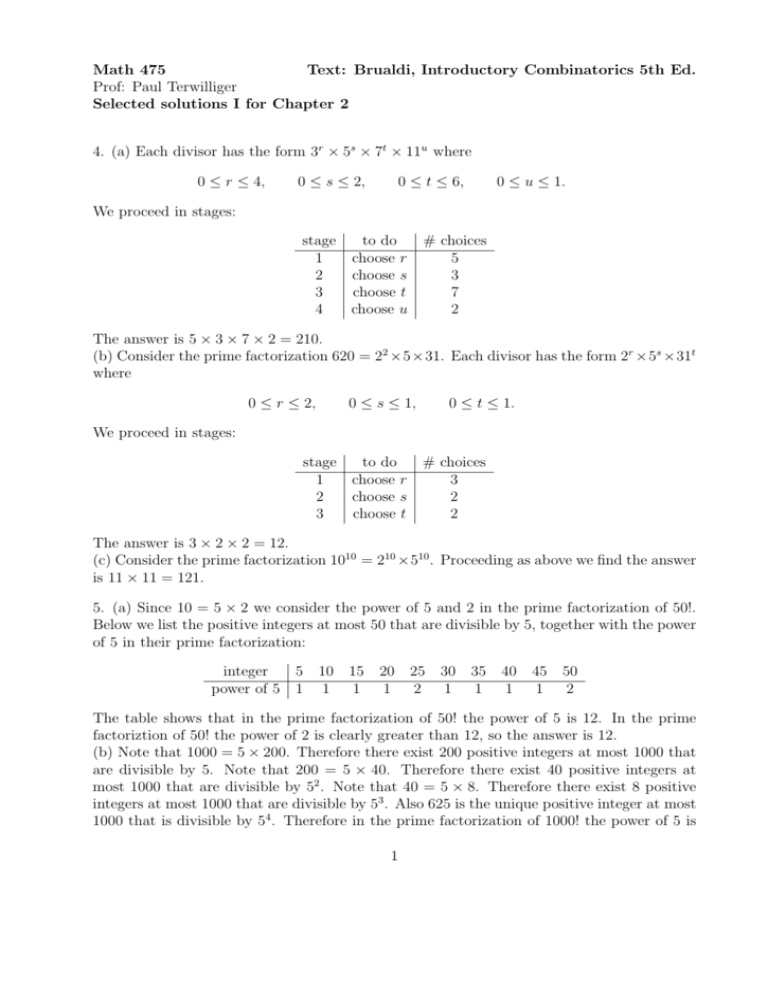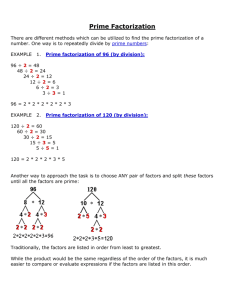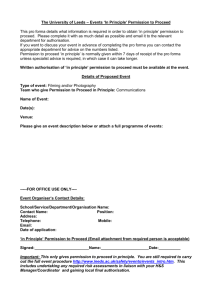Solutions Chapter 2
advertisement

Math 475 Text: Brualdi, Introductory Combinatorics 5th Ed. Prof: Paul Terwilliger Selected solutions I for Chapter 2 4. (a) Each divisor has the form 3r × 5s × 7t × 11u where 0 ≤ r ≤ 4, 0 ≤ s ≤ 2, 0 ≤ t ≤ 6, 0 ≤ u ≤ 1. We proceed in stages: stage to do 1 choose r choose s 2 3 choose t choose u 4 # choices 5 3 7 2 The answer is 5 × 3 × 7 × 2 = 210. (b) Consider the prime factorization 620 = 22 ×5×31. Each divisor has the form 2r ×5s ×31t where 0 ≤ r ≤ 2, 0 ≤ s ≤ 1, 0 ≤ t ≤ 1. We proceed in stages: stage to do 1 choose r 2 choose s 3 choose t # choices 3 2 2 The answer is 3 × 2 × 2 = 12. (c) Consider the prime factorization 1010 = 210 ×510 . Proceeding as above we find the answer is 11 × 11 = 121. 5. (a) Since 10 = 5 × 2 we consider the power of 5 and 2 in the prime factorization of 50!. Below we list the positive integers at most 50 that are divisible by 5, together with the power of 5 in their prime factorization: integer power of 5 5 1 10 1 15 1 20 1 25 2 30 1 35 1 40 1 45 1 50 2 The table shows that in the prime factorization of 50! the power of 5 is 12. In the prime factoriztion of 50! the power of 2 is clearly greater than 12, so the answer is 12. (b) Note that 1000 = 5 × 200. Therefore there exist 200 positive integers at most 1000 that are divisible by 5. Note that 200 = 5 × 40. Therefore there exist 40 positive integers at most 1000 that are divisible by 52 . Note that 40 = 5 × 8. Therefore there exist 8 positive integers at most 1000 that are divisible by 53 . Also 625 is the unique positive integer at most 1000 that is divisible by 54 . Therefore in the prime factorization of 1000! the power of 5 is 1 200 + 40 + 8 + 1 = 249. In the prime factorization of 1000! the power of 2 is greater than 249. Therefore the answer is 249. 6. Consider the set S of integers that meet the requirements. We find |S|. The maximal integer in S is 98654310, and this has 8 digits. The minimal integer in S is 5401, with 4 digits. For 4 ≤ n ≤P8 let Sn denote the set of integers in S that have exactly n digits. By construction |S| = 8n=4 |Sn |. To find |S8 |, we count the number of elements in S8 by filling in the blanks left to right: # choices : 7 7 6 5 4 3 2 1 So |S8 | = 7 × 7!. More generally we find n 8 |Sn | 7 × 7! 7 7 × P (7, 6) 6 7 × P (7, 5) 5 7 × P (7, 4) To find |S4 | we partition S4 into four subsets as follows: type of element has form 540∗ has form 54 ∗ ∗ but not 540∗ has form 5 ∗ ∗∗ but not 54 ∗ ∗ has form ∗ ∗ ∗∗ but not 5 ∗ ∗∗ # choices 5 5×5 3×6×5 3×7×6×5 So |S4 | = 5 + 5 × 5 + 3 × 6 × 5 + 3 × 7 × 6 × 5 = 5 + 25 + 90 + 630 = 750. Therefore |S| = 7 × 7! + 7 × P (7, 6) + 7 × P (7, 5) + 7 × P (7, 4) + 750. 7. Pick a man and call him H. We proceed in stages: stage to do # choices 1 order the remaining men clockwise from H 3! order the women clockwise from H 8! 2 The answer is 3! × 8!. 9. Declare A to be the head of the table. We proceed in stages: to do stage 1 pick the person to A’s right 2 pick the person to A’s left 3 order the remaining people clockwise in the remaining seats The answer is 13 × 12 × 12! = 12 × 13!. Now suppose that B only refuses to sit on A’s right. We proceed in stages: 2 # choices 13 12 12! stage to do 1 pick the person to A’s right 2 order the remaining people clockwise in the remaining seats # choices 13 13! The answer is 13 × 13!. 11. Let a < b < c denote the elements of the 3-integer set. Define x = a − 1, y = b − a − 2, z = c − b − 2, w = 20 − c. Then each of x, y, z, w is nonnegative and x + y + z + w = 15. Thus the desired quantity is equal to the number of integral solutions to x ≥ 0, y ≥ 0, z ≥ 0, w ≥ 0, This number is 15+4−1 = 18 by Theorem 2.5.1. 4−1 3 x + y + z + w = 15. 13. (a) We proceed in stages: stage to do # choices 1 fill dorm A 100 25 2 fill dorm B 75 35 3 fill dorm C 1 The answer is 100 75 100! = . 25 35 25! × 35! × 40! (b) We proceed in stages: stage to do # choices 1 fill dorm A 50 25 2 fill dorm B 50 35 3 fill dorm C 1 The answer is 50 50 . 25 35 14. We proceed in stages: 3 stage to do # choices 1 seat the 5 front-row students P (8, 5) 2 seat the 4 back-row students P (8, 4) seat the remaining 5 students P (7, 5) 3 The answer is P (8, 5)P (8, 4)P (7, 5). 15. (a) Label the men 1, 2, . . . , 15. We proceed in stages: stage to do 1 pick the woman for man 1 pick the woman for man 2 2 · ··· · ··· pick the woman for man 15 15 # choices 20 19 · · 6 The answer is 20 × 19 × 18 × · · · × 6 = P (20, 15). (b) We proceed in stages: The answer is 15 10 stage to do # choices 1 pick 10 men 15 10 2 pick 10 women 20 10 3 match the above men and women 10! × 20 10 × 10!. 19. (a) We proceed in stages: stage to do 1 select red rook locations 8 5 5 2 select blue rook locations 3 3 3 The answer is 2 8 × 5! × 3!. 5 (b) We proceed in stages: 4 # choices 8 3 5! 3! stage to do # choices 1 select red rook locations 12 5 12 5 2 select blue rook locations 7 3 3 7 5! 3! The answer is 2 2 12 7 × × 5! × 3!. 5 3 26. (a) Name the teams 1, 2, . . . , m. We proceed in stages: stage to do # choices 1 select team 1 mn n 2 select team 2 mn−n n 3 select team 3 mn−2n n · · ··· ··· · · m select team m n n The answer is the product of the entries in the right-most colum, which comes to (mn)! . (n!)m (b) To get the answer, divide the answer to (a) by m!. The answer is (mn)! . m!(n!)m 27. By assumption there is a rook in the first row; suppose it is in column r. By assumption there is a rook in the first column; suppose it is in row s. Note that either (i) r = s = 1; or (ii) r 6= 1, s 6= 1. The number of solutions for case (i) is equal to the number of ways to place 4 nonattacking rooks on a 7 × 7 chessboard. Concerning (ii), there are 7 choices for r and 7 choices for s. For each r, s the number of solutions is equal to the number of ways to place 3 nonattacking rooks on a 6 × 6 chessboard. Therefore the answer is 2 2 7 6 2 4! × + 7 × 3! × . 4 3 5





